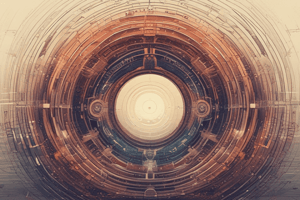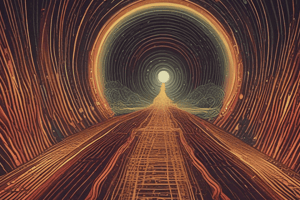Podcast
Questions and Answers
What is the term used to describe the frequency at which an object naturally vibrates?
What is the term used to describe the frequency at which an object naturally vibrates?
- Interference frequency
- Resonant frequency (correct)
- Amplitude frequency
- Vibrational frequency
Which of the following describes a standing wave?
Which of the following describes a standing wave?
- A wave created by waves that interfere with each other in opposite paths (correct)
- A wave that only exists in a vacuum
- A wave that travels indefinitely without interference
- A wave formed by two waves with matching frequencies moving in the same direction
What happens when a light wave's frequency matches the resonant frequency of an object?
What happens when a light wave's frequency matches the resonant frequency of an object?
- The light is reflected
- The light causes the object to glow
- The light is transmitted
- The light is absorbed (correct)
In the context of objects interacting with light, what characterizes an opaque object?
In the context of objects interacting with light, what characterizes an opaque object?
What phenomenon occurs in RLC circuits where induction and capacitance balance each other out?
What phenomenon occurs in RLC circuits where induction and capacitance balance each other out?
What happens to light waves when they reflect off a smooth surface?
What happens to light waves when they reflect off a smooth surface?
What is the phenomenon called when light waves enter a new medium and bend?
What is the phenomenon called when light waves enter a new medium and bend?
When a wave passes from one medium to another, what is the ratio that describes how a medium refracts a wave called?
When a wave passes from one medium to another, what is the ratio that describes how a medium refracts a wave called?
What type of interference occurs when two waves with the same frequency collide and produce a wave with a larger amplitude?
What type of interference occurs when two waves with the same frequency collide and produce a wave with a larger amplitude?
What occurs when an object absorbs all colors of light and appears black?
What occurs when an object absorbs all colors of light and appears black?
What is a common application of ultrasonic waves?
What is a common application of ultrasonic waves?
In the Doppler effect, how does the pitch of a sound change when the source is moving toward an observer?
In the Doppler effect, how does the pitch of a sound change when the source is moving toward an observer?
What causes an interference pattern when light passes through a slit?
What causes an interference pattern when light passes through a slit?
Why does a thinner aperture result in more diffraction?
Why does a thinner aperture result in more diffraction?
How is electric power measured?
How is electric power measured?
What is the significance of the direction of conventional current in conductors?
What is the significance of the direction of conventional current in conductors?
What role do resistors play in an electric circuit?
What role do resistors play in an electric circuit?
What phenomenon occurs when a sound source travels faster than the speed of sound?
What phenomenon occurs when a sound source travels faster than the speed of sound?
What does a blue shifted galaxy indicate about its movement?
What does a blue shifted galaxy indicate about its movement?
Which theory was supported by the results of the Double Slit Experiment?
Which theory was supported by the results of the Double Slit Experiment?
What determines the energy of electrons emitted in the photoelectric effect according to Einstein?
What determines the energy of electrons emitted in the photoelectric effect according to Einstein?
What is the main difference between real images and virtual images formed by lenses?
What is the main difference between real images and virtual images formed by lenses?
What is the bending of light when it passes from one medium to another called?
What is the bending of light when it passes from one medium to another called?
What is a convex lens primarily characterized by?
What is a convex lens primarily characterized by?
What type of light wave behavior does diffraction illustrate?
What type of light wave behavior does diffraction illustrate?
What property of light does polarization refer to?
What property of light does polarization refer to?
What is stated by the law of reflection regarding the angles of incidence and reflection?
What is stated by the law of reflection regarding the angles of incidence and reflection?
Flashcards are hidden until you start studying
Study Notes
Resonance and Waves
- Resonance occurs when a specific vibration frequency amplifies an object's natural vibrations, increasing amplitude from equilibrium.
- The resonant frequency, also called natural frequency, is where an object naturally vibrates.
- Standing waves form when two waves of matching frequencies interfere; they include nodes (non-displaced points) and antinodes (highest amplitude points).
- RLC circuits experience resonance when inductance and capacitance are equal, canceling each other out.
- Musical instruments amplify sound waves via resonators; for example, a trumpet's air column amplifies vibrations from the musician's lips.
- Light waves exhibit resonance; if the light wave frequency matches an object's resonant frequency, absorption occurs, while mismatched frequencies result in reflection.
Light Interaction with Objects
- Objects are classified as opaque, transparent, or translucent based on their interaction with light.
- Opaque objects block light, making items on the other side invisible; they absorb light at matching frequencies through resonance.
- Reflection occurs when light waves bounce back, with specular reflection on smooth surfaces and diffuse reflection on rough surfaces.
- Transmission happens when light passes through objects without slowing down, typical in transparent materials; Snell's Law states light speed remains constant in these mediums.
- Refraction occurs when light enters a denser medium, bending light waves, causing translucent objects to appear blurry.
Color and Wavelengths
- Color is determined by specific wavelengths of light reflecting off matter; white light contains all colors in the visible spectrum.
- Objects appear a certain color due to pigments that absorb all other colors of light; white reflects all colors while black absorbs all.
Refraction and Angles
- Refraction is the bending of waves when transitioning between mediums; the angle of incidence compares with the angle of refraction.
- The index of refraction characterizes how much a medium refracts light, relating to angles according to Snell's Law.
- Dispersion occurs when white light passes through a prism, separating frequencies into a visible rainbow due to differing refraction angles.
Diffraction and Interference
- Diffraction is the bending of waves around objects or apertures, requiring the aperture size to match or be smaller than the wavelength.
- Light shows interference patterns when passing through an aperture, creating alternating light and dark areas (constructive and destructive interference).
- Sound waves also display diffraction characteristics where slower waves travel longer distances.
Wave Interference
- Wave interference involves two types: constructive (larger amplitude when waves combine) and destructive (cancellation when crest meets trough).
- The Principle of Superposition states that the sum of wave displacements equals the resultant amplitude.
- Standing waves result from reflection and constructive interference, maintaining the same frequency in contained mediums.
Doppler Effect
- The Doppler effect describes the perceived frequency change of waves from a moving source, observable in sound and light.
- As the source moves closer, sound appears higher in pitch; as it recedes, pitch lowers. Edwin Hubble applied this to galaxies, using Doppler shifts to demonstrate the universe's expansion.
Wave-Particle Duality
- Debate over light's nature shifted through history; Newton's particle theory versus Huygens' wave theory culminated in evidence of wave-particle duality.
- Light behaves as both a wave (diffraction) and particle (photoelectric effect), leading to the conclusion that all mass-bearing particles exhibit duality, as demonstrated by De Broglie.
Properties of Light
- Light properties include intensity, direction, frequency (color), and polarization.
- Light travels in straight lines, reflecting symmetrically off mirrors and bending at interfaces (refraction).
Lenses and Imaging
- Lenses manipulate light via refraction, categorized as convex (converging) and concave (diverging) with distinct imaging characteristics.
- Ray diagrams help predict image characteristics produced by lenses; real images form on the opposite side and can be projected, while virtual images cannot.
Additional Properties
- Diffraction creates interference patterns when light waves overlap; the aperture size influences the pattern's dimensions.
- Light's frequency determines its color, with filters only allowing colors matching their own wavelengths to pass.
Electric Power and Circuits
- Electric power is the rate of energy transfer, measured in watts; one watt equals one joule per second.
- Voltage differences drive electric currents, which flow from positive to negative poles, facilitating the operation of various devices.
- Electric current in conductors either takes direct current (DC) with fixed direction or alternating current (AC) which varies in direction.
- An electric circuit’s components, such as resistors, reduce current flow based on Ohm's law (resistance equals voltage divided by current).
Energy Sources
- Voltage sources, such as batteries, convert chemical energy to electrical energy; other sources include nuclear, coal, natural gas, hydroelectric, and wind power.### Generators and Voltage Sources
- Generators convert different energy types into electrical energy using moving magnets and electromagnetic induction.
- Voltage is produced by pushing electrons in a wire in one direction.
- All voltage sources share the principle of energy conversion to generate voltage.
Ohm's Law and Circuit Relationships
- Georg Simon Ohm established the relationship between resistance, current, and voltage in 1827.
- Current measures the flow of electric charge in a conductor over a time interval.
- Voltage represents the potential difference between two points in a wire or component.
- Resistance quantifies the opposition to current flow in a circuit.
- Ohm's Law: Current is directly proportional to voltage and inversely proportional to resistance.
- Key formulas:
- Voltage (V) = Current (I) x Resistance (R)
- Resistance (R) = Voltage (V) / Current (I)
- Current (I) = Voltage (V) / Resistance (R)
- Ohmic materials, like metals at specific temperatures, obey Ohm's law, while non-ohmic devices (semiconductors, diodes, transistors) do not.
Types of Electric Circuits
- Electric circuits create complete loops for electron flow from a voltage or current source.
- Series circuits connect all components in a single loop; voltage is divided, and current remains constant.
- Parallel circuits have components on separate branches; current is split while voltage is uniform across branches.
Conductors and Insulators
- Conductors allow free flow of electric current, enabling electron movement.
- Insulators restrict or block electric current.
- Examples of conductors: iron, copper, salt water; examples of insulators: rubber, plastic, wood.
Electrical Resistance
- Electrical resistance is the opposition to current flow, measured in ohms.
- Resistance arises from the random motion and collisions of free electrons in a conductor.
- Conductance is the reciprocal of resistance, measured in siemens.
- Key factors affecting resistance:
- Length of conductor
- Cross-sectional area of conductor
- Temperature of conductor
- Resistance can be static (DC circuits) or dynamic (AC circuits) and is used to control current or convert electrical energy to heat.
Concept of Voltage
- Charged particles store potential energy when densely packed.
- Voltage indicates the work capacity of charged particles in a circuit, likened to pressure in a pipe.
- Charge density affects the voltage level within a battery or collection of charges.
- Voltage is measured in joules per coulomb (volts).
Studying That Suits You
Use AI to generate personalized quizzes and flashcards to suit your learning preferences.




